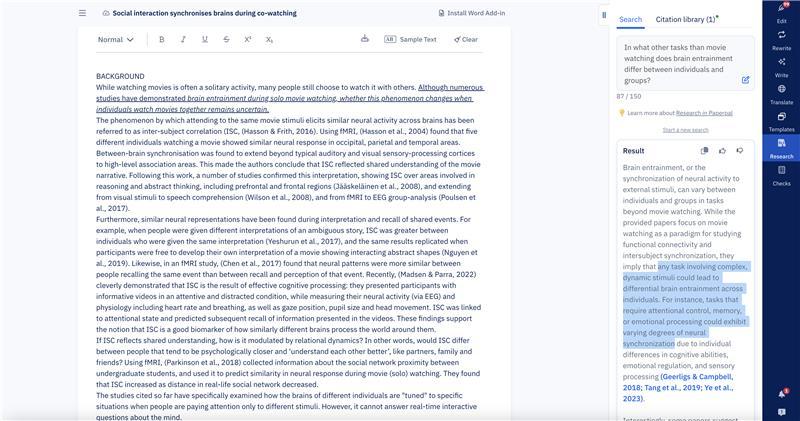As your research gets more intricate with time and experience, it requires the collective efforts of appropriate collaborators from broader disciplines to provide fresh perspectives. By facilitating research collaboration across disciplines, you can leverage the technical knowledge and skills from various experts, which can help you zoom out and approach the research problem in a way you may not have considered before.
These mutually rewarding partnerships can take various forms, be it interdisciplinary research collaborations within your academic institution or with other institutions. The cultural context and impact are broadened further with tie-ups internationally at an individual or institutional level. Industry-academia partnerships are also gaining momentum in pushing the envelope of research impact, driven by the resources and public presence of industries and the expertise of academics in developing cutting-edge products and technologies.
A glowing example of an impactful and far-reaching research collaboration is for the Large Hadron Collider, which is credited with first detecting the infamous Higgs boson particle that is responsible for transferring mass to fundamental particles. It took the concerted effort and academic research collaboration of more than 10,000 scientists from across 100 countries to discover this fundamental piece of existence that has shaped the world as we know it. Back in 1998, this interdisciplinary research collaboration was facilitated by the European Organization for Nuclear Research (CERN), leading to the discovery of the Higgs Boson in 2012.
Cut to the present, collaborative interdisciplinary research is becoming indispensable to academic success in an increasingly connected world. Laying the foundation for an effective scientific network that can support your research investigation across domains is thus becoming increasingly relevant. Additionally, developing a wider understanding across disciplines and receiving swift responses to your queries to validate your findings is indispensable to winning the race against time to publish. While you focus on building your network, AI tools like Paperpal enable you to quickly grasp new concepts across disciplines, which can help you steer your research in the right direction.
How Paperpal Can Help Drive Interdisciplinary Research Collaboration
Most generative AI applications today are synonymous with generating text, video, and images; their influence on solving real world problems is still in the works for the most part. With the right amalgamation of large language models and academic databases, this gap can be addressed. Paperpal’s Research feature presents an intriguing opportunity for researchers in this regard.
Paperpal’s Research feature allows you to ask a research question and get a coherent, factual response that taps into a corpus of over 250 million research articles. Each response comes with a list of verified sources, with which you can create your personal citation library of relevant research papers. While this feature fills a more obvious demand to help researchers get literature-backed answers to validate ideas and support arguments, it also serves a latent need. The citations provided with these AI responses can serve as a first step to identifying research groups and institutions that you can approach to gain diverse inputs and expertise for your own work.
Particularly, the limitations that you identify in your research can serve as a good starting point to invite added expertise from other domains and address them effectively. For instance, if a major limitation of your investigation is that your data was collected at a certain time period or with certain conditions that constrain the generalizability of your study, you could explore studies that have used data sets that did not have the same constraints as yours.

Shortlisting such studies and reaching out to the corresponding author with a friendly email to propose knowledge and resource exchange can be a small but significant step in addressing the shortcomings of your current research and paving paths for fruitful research collaborations not limited by domains or geography.
While developing certain sections of your draft like the Introduction or Discussion sections, you can also use the Research feature to broaden your horizon and develop a line of argument that draws from not just your immediately relevant research topic, but also from allied fields that help you in developing a stronger and well-researched foundation for your article.

If you’re looking for science-backed responses to research questions, want to quickly understand concepts from other fields of research, or develop insights that could help shape your research, Paperpal is perfect for you. Not only does the AI assistant help you research, write, and cite without ever having to switch tabs, it has everything you need to deliver polished, high-quality writing in half the time. Try Paperpal for FREE today and explore new avenues for interdisciplinary research collaboration!
Paperpal is a comprehensive AI writing toolkit that helps students and researchers achieve 2x the writing in half the time. It leverages 21+ years of STM experience and insights from millions of research articles to provide in-depth academic writing, language editing, and submission readiness support to help you write better, faster.
Get accurate academic translations, rewriting support, grammar checks, vocabulary suggestions, and generative AI assistance that delivers human precision at machine speed. Try for free or upgrade to Paperpal Prime starting at US$19 a month to access premium features, including consistency, plagiarism, and 30+ submission readiness checks to help you succeed.
Experience the future of academic writing – Sign up to Paperpal and start writing for free!



